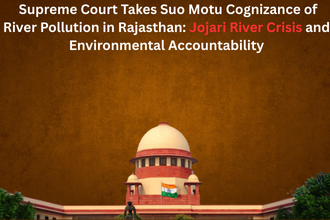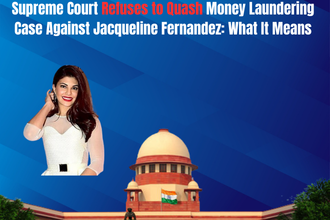On September 16, 2025, the Supreme Court of India took suo motu cognizance of the rising issue of river pollution in Rajasthan, particularly in the Jojari river, which has been plagued with industrial contamination for nearly two decades. The matter has now been registered as a Public Interest Litigation (PIL) following the Court’s intervention, marking a significant step toward addressing one of Rajasthan’s long-standing environmental challenges.
The Bench of Justice Vikram Nath and Justice Sandeep Mehta directed the Court Registry to register the case, leaving the final decision on future proceedings to the Chief Justice of India (CJI). While the Court has not yet clarified whether its cognizance covers only the Jojari river or the larger issue of river pollution in Rajasthan, the move has generated widespread attention among environmentalists, legal experts, and affected local communities.
The Jojari River Pollution Crisis: A Two-Decade Struggle
The Jojari river, a tributary of the Luni river, flows through Jodhpur and Pali districts in Rajasthan. Over the last twenty years, it has become a toxic stream carrying untreated industrial effluents, primarily from textile dyeing, chemical units, and tanneries in the region.
Reports, including those from Mongabay India, highlight that around 50 villages and hamlets along the river’s stretch have been severely impacted by the discharge of untreated wastewater. The pollution has contaminated groundwater, destroyed farmlands, and exposed villagers to serious health risks, including skin diseases, gastrointestinal illnesses, and respiratory problems.
The situation is dire because most residents of these villages depend on agriculture and livestock for survival. With soil and water rendered unsafe, their livelihoods have suffered dramatically. The Jojari river, once a lifeline, has become a carrier of poison.
Supreme Court’s Suo Motu Intervention
Suo motu cognizance by the Supreme Court means the Court has acted on its own, without waiting for a petition from an affected party. In this case, the Court appears to have acted on the basis of recent media reports about the Jojari river.
Justice Vikram Nath, while announcing the decision, stated:
“Hon’ble CJI will take a call and pass appropriate order.”
This step signals the judiciary’s willingness to intervene in environmental governance, especially when prolonged inaction by state authorities has worsened the crisis.
Legal Context: Environmental Protection under Indian Law
India’s environmental jurisprudence has been shaped by several landmark cases where the judiciary invoked Article 21 of the Constitution (Right to Life) to protect the right to a clean and healthy environment.
Some important precedents relevant to this case include:
- M.C. Mehta v. Union of India (1988, Ganga Pollution Case): The Supreme Court directed closure of polluting tanneries along the Ganga river, holding that industries must not operate at the cost of public health.
- Vellore Citizens Welfare Forum v. Union of India (1996): Introduced the precautionary principle and the polluter pays principle into Indian law.
- Indian Council for Enviro-Legal Action v. Union of India (1996): The Court emphasized accountability of industries for environmental damage.
In light of these judgments, the pollution of the Jojari river raises direct questions about the responsibility of industries, state pollution control boards, and the Rajasthan government in failing to protect public health and ecology.
Government and Regulatory Failures
While the Rajasthan State Pollution Control Board (RSPCB) and other authorities are tasked with monitoring industrial discharge, ground reports suggest systemic negligence and lack of enforcement. Despite repeated directives in the past from the Rajasthan High Court and the National Green Tribunal (NGT), the problem persists.
Key reasons for regulatory failure include:
- Ineffective Treatment Plants: Many Common Effluent Treatment Plants (CETPs) in Pali and Jodhpur either function below capacity or fail to treat waste adequately.
- Illegal Discharge: Several small industries discharge untreated wastewater directly into drains leading to the Jojari river.
- Weak Enforcement: Industries often escape penalties due to corruption, delays in inspections, and lack of political will.
- Poor Rehabilitation Measures: Villagers have not been provided safe drinking water or adequate compensation for agricultural losses.
Environmental and Human Rights Dimensions
The right to clean water and pollution-free environment is a recognized part of the fundamental right to life under Article 21. The Jojari river crisis is therefore not merely an environmental issue but a human rights violation.
- Health Impact: The continuous exposure to toxic pollutants has increased diseases in local populations, particularly among children and women.
- Agricultural Damage: Farmlands irrigated with contaminated water have become infertile, worsening rural poverty.
- Ecological Damage: Aquatic life in the river has been severely affected, reducing biodiversity and impacting the overall ecosystem.
Possible Directions the Supreme Court May Issue
While the case is still at an early stage, the Supreme Court may consider issuing directions such as:
- Strict enforcement of “polluter pays” principle on industries discharging untreated waste.
- Independent monitoring of CETPs and industrial units by a court-appointed committee.
- Compensation and rehabilitation measures for affected villagers under the Public Liability Insurance Act or through state schemes.
- Directions to the Rajasthan government and Pollution Control Board for a time-bound action plan to restore the Jojari river.
- Guidelines for long-term prevention of industrial water pollution in Rajasthan.
Suo Motu Cases on Environmental Issues: A Growing Trend
This case adds to the growing list of instances where the Supreme Court has intervened suo motu to address environmental concerns. Recent examples include:
- Suo motu action on air pollution in Delhi-NCR.
- Suo motu proceedings on illegal sand mining.
- Directions to states on management of hazardous waste.
Such actions highlight the judiciary’s role as a custodian of environmental justice, especially when executive agencies fail to act.
Conclusion
The Supreme Court’s decision to take suo motu cognizance of river pollution in Rajasthan is a significant step toward addressing decades of negligence. The plight of 50 villages along the Jojari river stands as a grim reminder of the consequences of unchecked industrial growth and weak regulatory enforcement.
The outcome of this case could set a new precedent for holding industries and state authorities accountable for long-term environmental damage. It also reaffirms that access to clean water and a pollution-free environment are fundamental rights that cannot be compromised.
As the proceedings unfold, all eyes will be on how the CJI and the Supreme Court Bench shape the future course of action. For the people of Rajasthan who have lived with toxic rivers for decades, this suo motu action carries a promise of long-awaited justice.
Also Read



